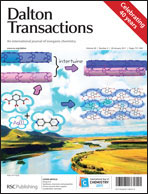Exchange coupling through diamagnetic [Fe(CO)4]2− bridging ligands in a xenophilic cluster†
Abstract
The electronic structure of so-called ‘xenophilic’ clusters, which contain both organometallic fragments and Werner-type paramagnetic transition metal centres, presents a challenge to simple theories of bonding. Density functional theory shows clearly that the cluster Mn2(thf)4(Fe(CO)4)2 is best described as an exchange-coupled MnII2 dimer, the closed-shell organometallic [Fe(CO)4]2− fragments acting simply as bridging
![Graphical abstract: Exchange coupling through diamagnetic [Fe(CO)4]2− bridging ligands in a xenophilic cluster](/en/Image/Get?imageInfo.ImageType=GA&imageInfo.ImageIdentifier.ManuscriptID=C0DT01221A&imageInfo.ImageIdentifier.Year=2011)

 Please wait while we load your content...
Please wait while we load your content...